ignition HYUNDAI I40 2014 Owners Manual
[x] Cancel search | Manufacturer: HYUNDAI, Model Year: 2014, Model line: I40, Model: HYUNDAI I40 2014Pages: 534, PDF Size: 11.05 MB
Page 17 of 534
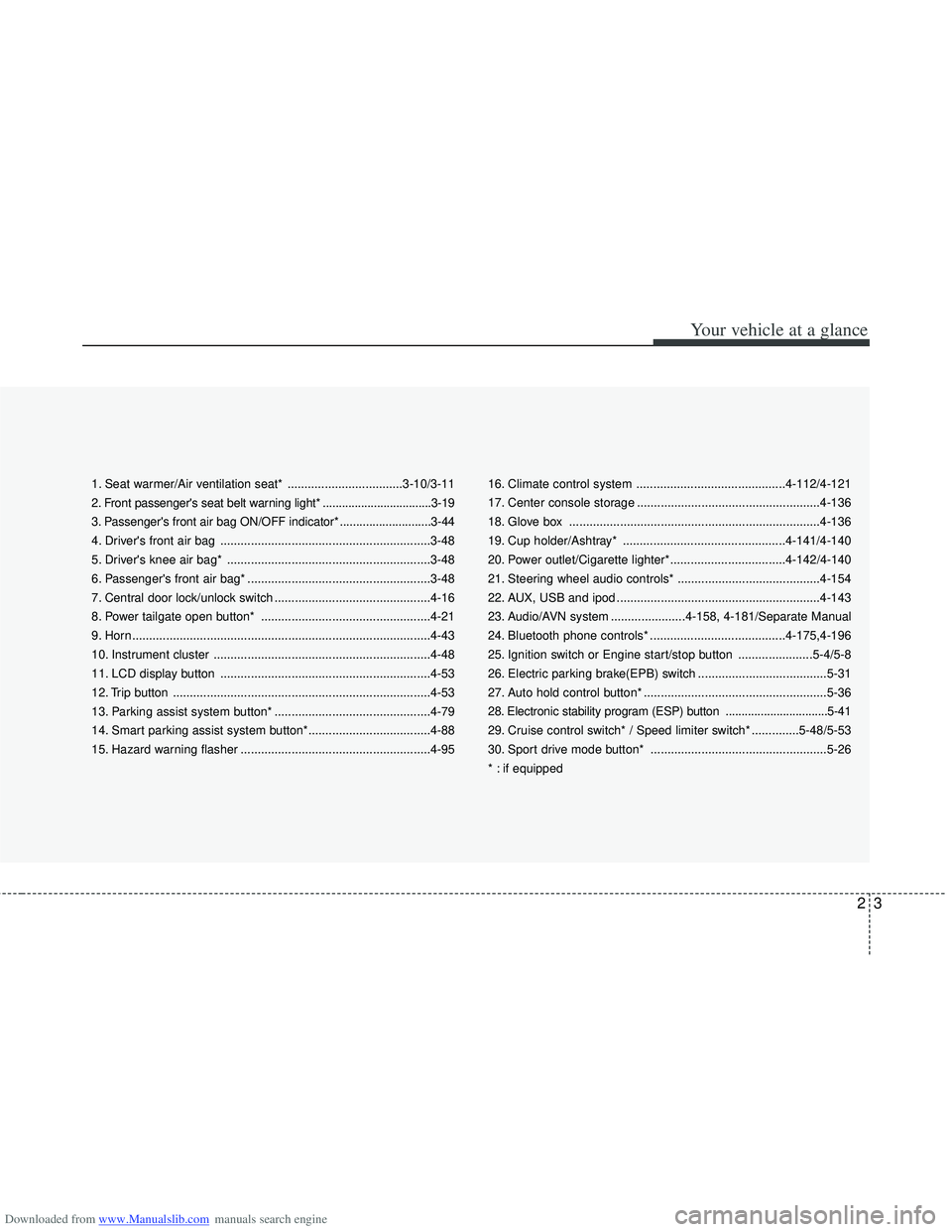
Downloaded from www.Manualslib.com manuals search engine 23
Your vehicle at a glance
1. Seat warmer/Air ventilation seat* ..................................3-10/3-11
2. Front passenger's seat belt warning light* ..................................3-19
3. Passenger's front air bag ON/OFF indicator* ............................3-44
4. Driver's front air bag ..............................................................3-48
5. Driver's knee air bag* ............................................................3-48
6. Passenger's front air bag* ......................................................3-48
7. Central door lock/unlock switch ..............................................4-16
8. Power tailgate open button* ..................................................4-21
9. Horn........................................................................\
................4-43
10. Instrument cluster ................................................................4-48
11. LCD display button ..............................................................4-53
12. Trip button ........................................................................\
....4-53
13. Parking assist system button* ..............................................4-79
14. Smart parking assist system button*....................................4-88
15. Hazard warning flasher ........................................................4-9516. Climate control system ............................................4-112/4-121
17. Center console storage ......................................................4-136
18. Glove box ........................................................................\
..4-136
19. Cup holder/Ashtray* ................................................4-141/4-140
20. Power outlet/Cigarette lighter*..................................4-142/4-140
21. Steering wheel audio controls* ..........................................4-154
22. AUX, USB and ipod ............................................................4-143
23. Audio/AVN system ......................4-158, 4-181/Separate Manual
24. Bluetooth phone controls* ........................................4-175,4-196
25. Ignition switch or Engine start/stop button ......................5-4/5-8
26. Electric parking brake(EPB) switch ......................................5-31
27. Auto hold control button* ......................................................5-36
28. Electronic stability program (ESP) button ................................5-41
29. Cruise control switch* / Speed limiter switch* ..............5-48/5-53
30. Sport drive mode button* ....................................................5-26
* : if equipped
Page 19 of 534
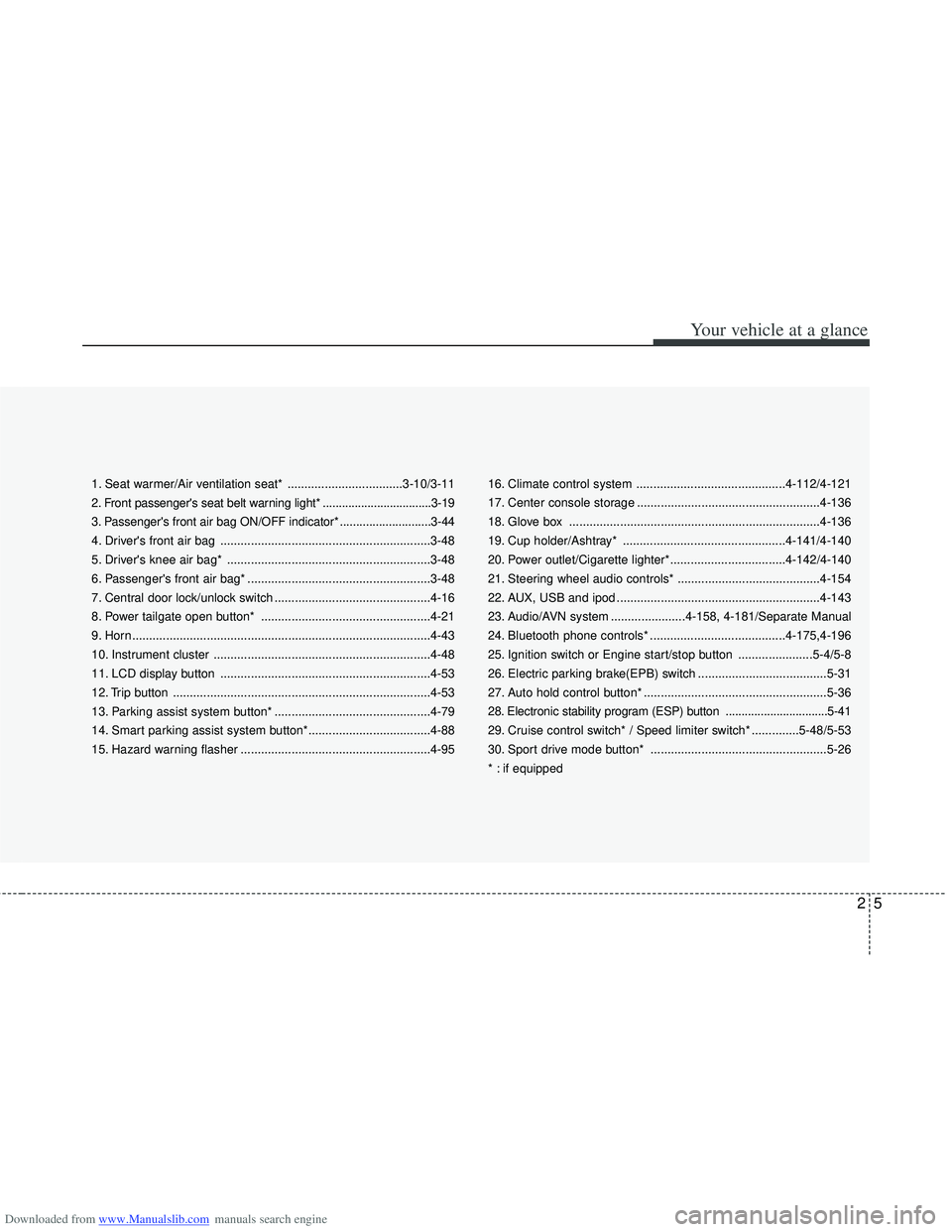
Downloaded from www.Manualslib.com manuals search engine 25
Your vehicle at a glance
1. Seat warmer/Air ventilation seat* ..................................3-10/3-11
2. Front passenger's seat belt warning light* ..................................3-19
3. Passenger's front air bag ON/OFF indicator* ............................3-44
4. Driver's front air bag ..............................................................3-48
5. Driver's knee air bag* ............................................................3-48
6. Passenger's front air bag* ......................................................3-48
7. Central door lock/unlock switch ..............................................4-16
8. Power tailgate open button* ..................................................4-21
9. Horn........................................................................\
................4-43
10. Instrument cluster ................................................................4-48
11. LCD display button ..............................................................4-53
12. Trip button ........................................................................\
....4-53
13. Parking assist system button* ..............................................4-79
14. Smart parking assist system button*....................................4-88
15. Hazard warning flasher ........................................................4-9516. Climate control system ............................................4-112/4-121
17. Center console storage ......................................................4-136
18. Glove box ........................................................................\
..4-136
19. Cup holder/Ashtray* ................................................4-141/4-140
20. Power outlet/Cigarette lighter*..................................4-142/4-140
21. Steering wheel audio controls* ..........................................4-154
22. AUX, USB and ipod ............................................................4-143
23. Audio/AVN system ......................4-158, 4-181/Separate Manual
24. Bluetooth phone controls* ........................................4-175,4-196
25. Ignition switch or Engine start/stop button ......................5-4/5-8
26. Electric parking brake(EPB) switch ......................................5-31
27. Auto hold control button* ......................................................5-36
28. Electronic stability program (ESP) button ................................5-41
29. Cruise control switch* / Speed limiter switch* ..............5-48/5-53
30. Sport drive mode button* ....................................................5-26
* : if equipped
Page 30 of 534
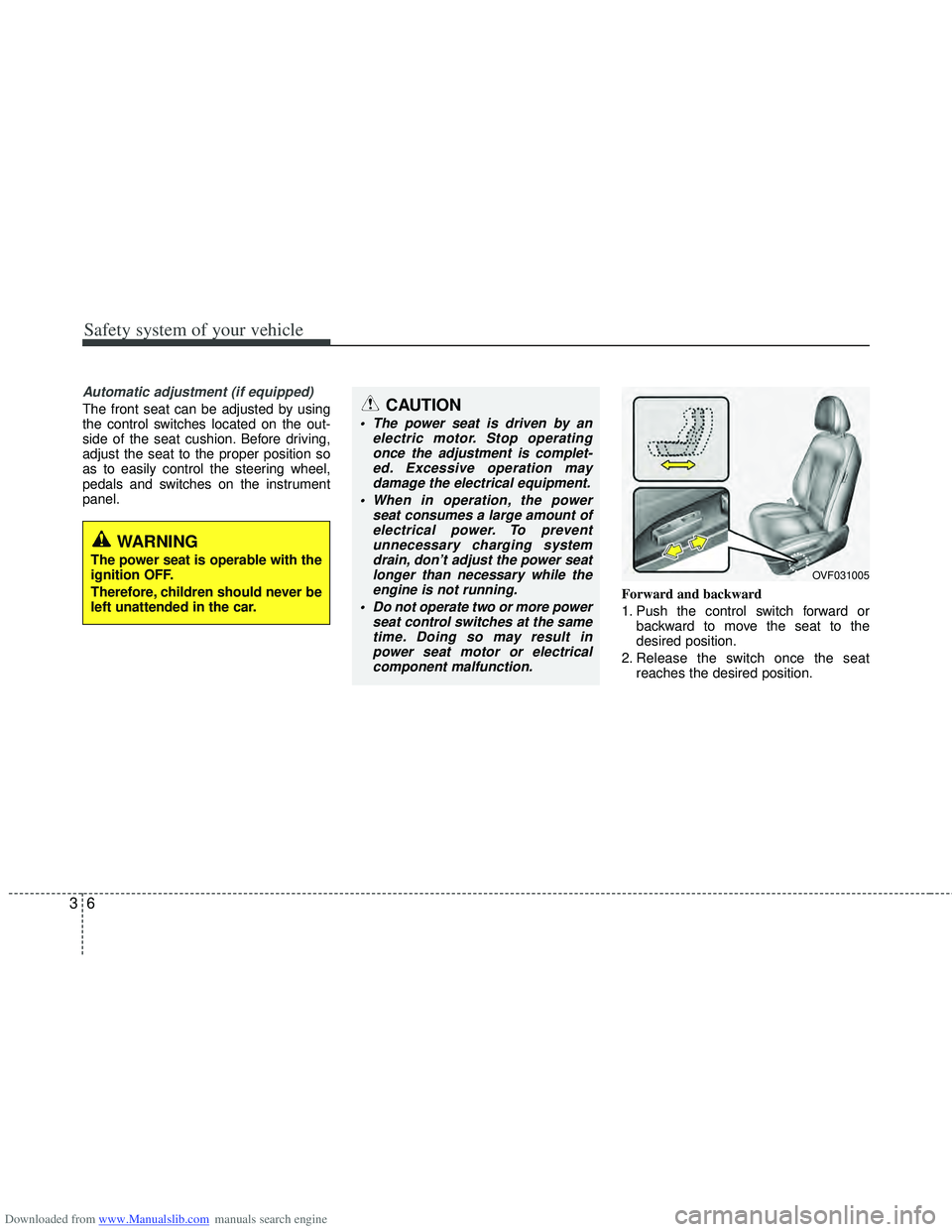
Downloaded from www.Manualslib.com manuals search engine Safety system of your vehicle
63
Automatic adjustment (if equipped)
The front seat can be adjusted by using
the control switches located on the out-
side of the seat cushion. Before driving,
adjust the seat to the proper position so
as to easily control the steering wheel,
pedals and switches on the instrument
panel.Forward and backward
1. Push the control switch forward orbackward to move the seat to the
desired position.
2. Release the switch once the seat reaches the desired position.
WARNING
The power seat is operable with the
ignition OFF.
Therefore, children should never be
left unattended in the car.
CAUTION
The power seat is driven by an electric motor. Stop operatingonce the adjustment is complet-ed. Excessive operation maydamage the electrical equipment.
When in operation, the power seat consumes a large amount ofelectrical power. To preventunnecessary charging systemdrain, don’t adjust the power seatlonger than necessary while theengine is not running.
Do not operate two or more power seat control switches at the sametime. Doing so may result inpower seat motor or electricalcomponent malfunction.
OVF031005
Page 34 of 534
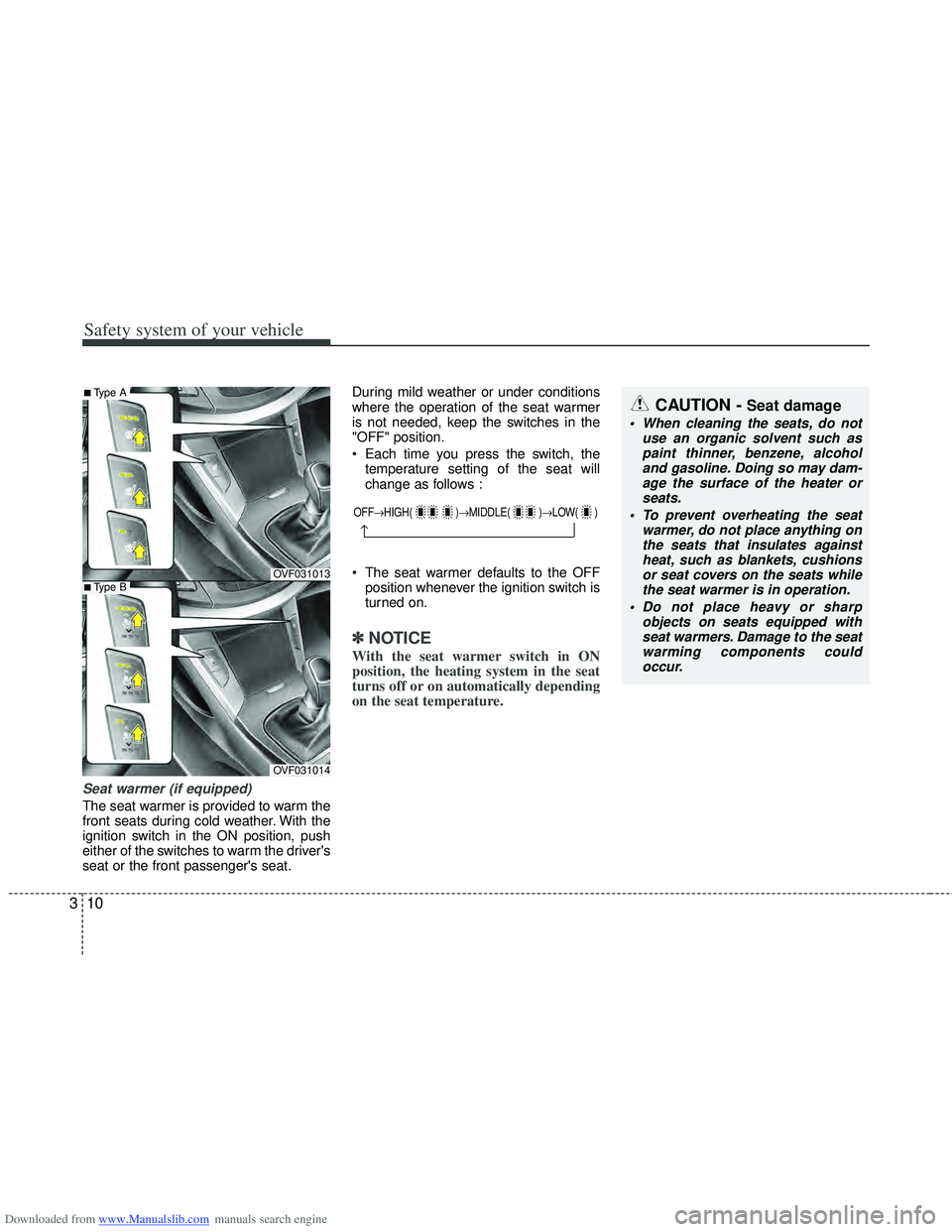
Downloaded from www.Manualslib.com manuals search engine Safety system of your vehicle
10
3
Seat warmer (if equipped)
The seat warmer is provided to warm the
front seats during cold weather. With the
ignition switch in the ON position, push
either of the switches to warm the driver's
seat or the front passenger's seat. During mild weather or under conditions
where the operation of the seat warmer
is not needed, keep the switches in the
"OFF" position.
Each time you press the switch, the
temperature setting of the seat will
change as follows :
The seat warmer defaults to the OFF position whenever the ignition switch is
turned on.
✽ ✽ NOTICE
With the seat warmer switch in ON
position, the heating system in the seat
turns off or on automatically depending
on the seat temperature.
OVF031013
OVF031014
OFF→ HIGH( )→ MIDDLE( )→LOW( )
→
■Type A
■Type B
CAUTION - Seat damage
When cleaning the seats, do not
use an organic solvent such aspaint thinner, benzene, alcohol and gasoline. Doing so may dam-age the surface of the heater orseats.
To prevent overheating the seat warmer, do not place anything onthe seats that insulates against heat, such as blankets, cushionsor seat covers on the seats while the seat warmer is in operation.
Do not place heavy or sharp objects on seats equipped withseat warmers. Damage to the seatwarming components couldoccur.
Page 35 of 534
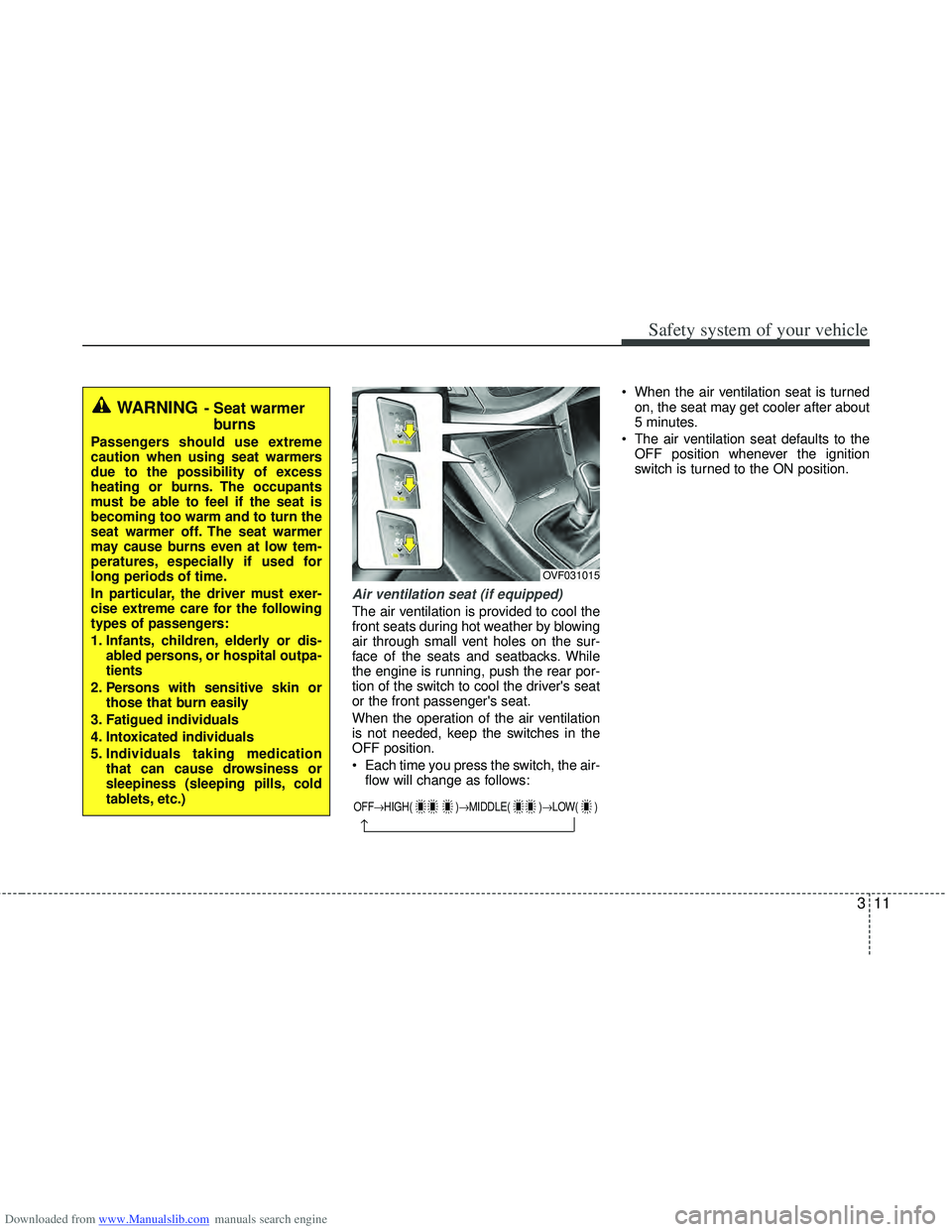
Downloaded from www.Manualslib.com manuals search engine 311
Safety system of your vehicle
Air ventilation seat (if equipped)
The air ventilation is provided to cool the
front seats during hot weather by blowing
air through small vent holes on the sur-
face of the seats and seatbacks. While
the engine is running, push the rear por-
tion of the switch to cool the driver's seat
or the front passenger's seat.
When the operation of the air ventilation
is not needed, keep the switches in the
OFF position.
Each time you press the switch, the air-flow will change as follows: When the air ventilation seat is turned
on, the seat may get cooler after about
5 minutes.
The air ventilation seat defaults to the OFF position whenever the ignition
switch is turned to the ON position.
OVF031015
OFF→ HIGH( )→ MIDDLE( )→LOW( )
→
WARNING- Seat warmer
burns
Passengers should use extreme
caution when using seat warmers
due to the possibility of excess
heating or burns. The occupants
must be able to feel if the seat is
becoming too warm and to turn the
seat warmer off. The seat warmer
may cause burns even at low tem-
peratures, especially if used for
long periods of time.
In particular, the driver must exer-
cise extreme care for the following
types of passengers:
1. Infants, children, elderly or dis-
abled persons, or hospital outpa-
tients
2. Persons with sensitive skin or those that burn easily
3. Fatigued individuals
4. Intoxicated individuals
5. Individuals taking medication that can cause drowsiness or
sleepiness (sleeping pills, cold
tablets, etc.)
Page 38 of 534
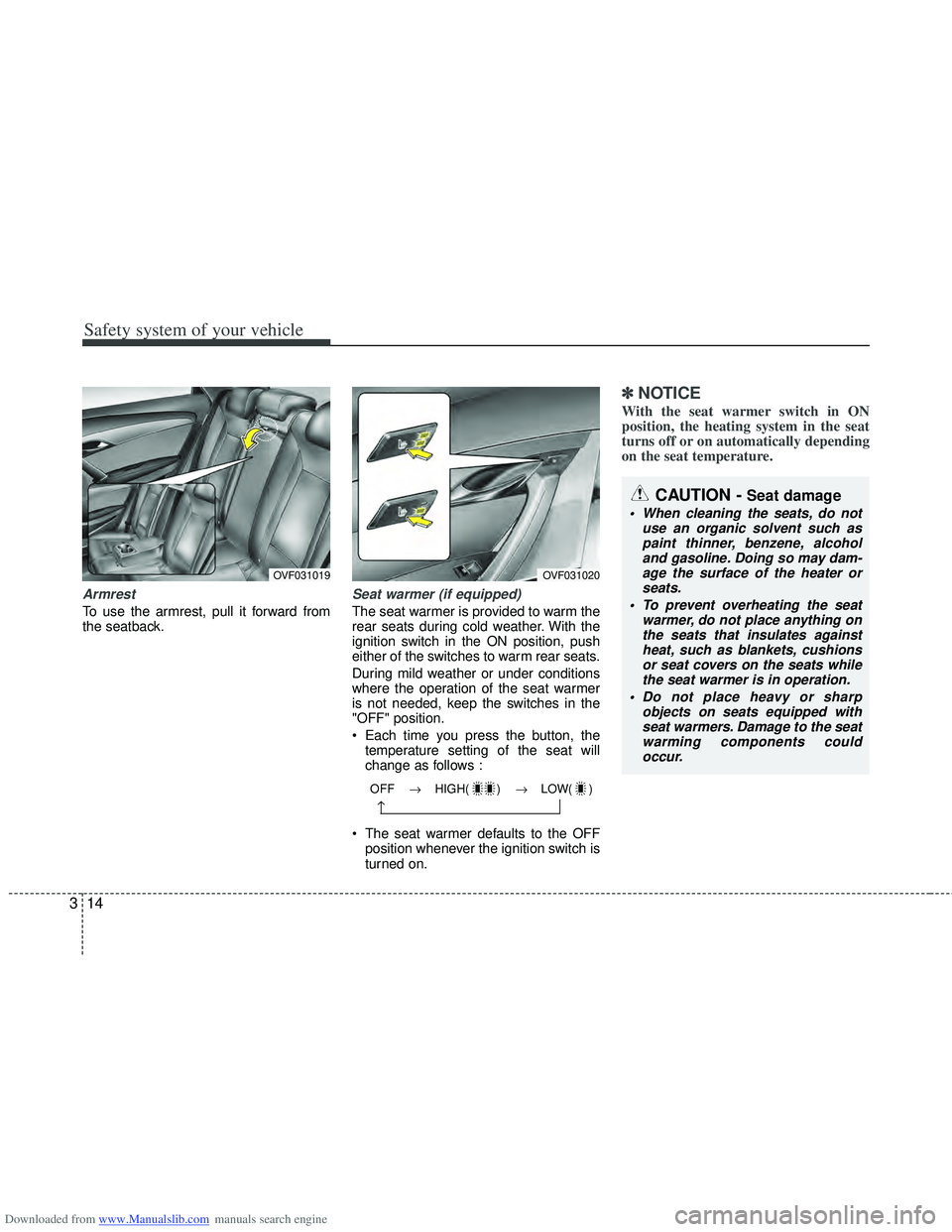
Downloaded from www.Manualslib.com manuals search engine Safety system of your vehicle
14
3
Armrest
To use the armrest, pull it forward from
the seatback.
Seat warmer (if equipped)
The seat warmer is provided to warm the
rear seats during cold weather. With the
ignition switch in the ON position, push
either of the switches to warm rear seats.
During mild weather or under conditions
where the operation of the seat warmer
is not needed, keep the switches in the
"OFF" position.
Each time you press the button, the
temperature setting of the seat will
change as follows :
The seat warmer defaults to the OFF position whenever the ignition switch is
turned on.
✽ ✽ NOTICE
With the seat warmer switch in ON
position, the heating system in the seat
turns off or on automatically depending
on the seat temperature.
OVF031020
OFF → HIGH( ) → LOW( )
→
OVF031019
CAUTION - Seat damage
When cleaning the seats, do not
use an organic solvent such aspaint thinner, benzene, alcoholand gasoline. Doing so may dam- age the surface of the heater orseats.
To prevent overheating the seat warmer, do not place anything onthe seats that insulates against heat, such as blankets, cushionsor seat covers on the seats while the seat warmer is in operation.
Do not place heavy or sharp objects on seats equipped withseat warmers. Damage to the seatwarming components couldoccur.
Page 43 of 534
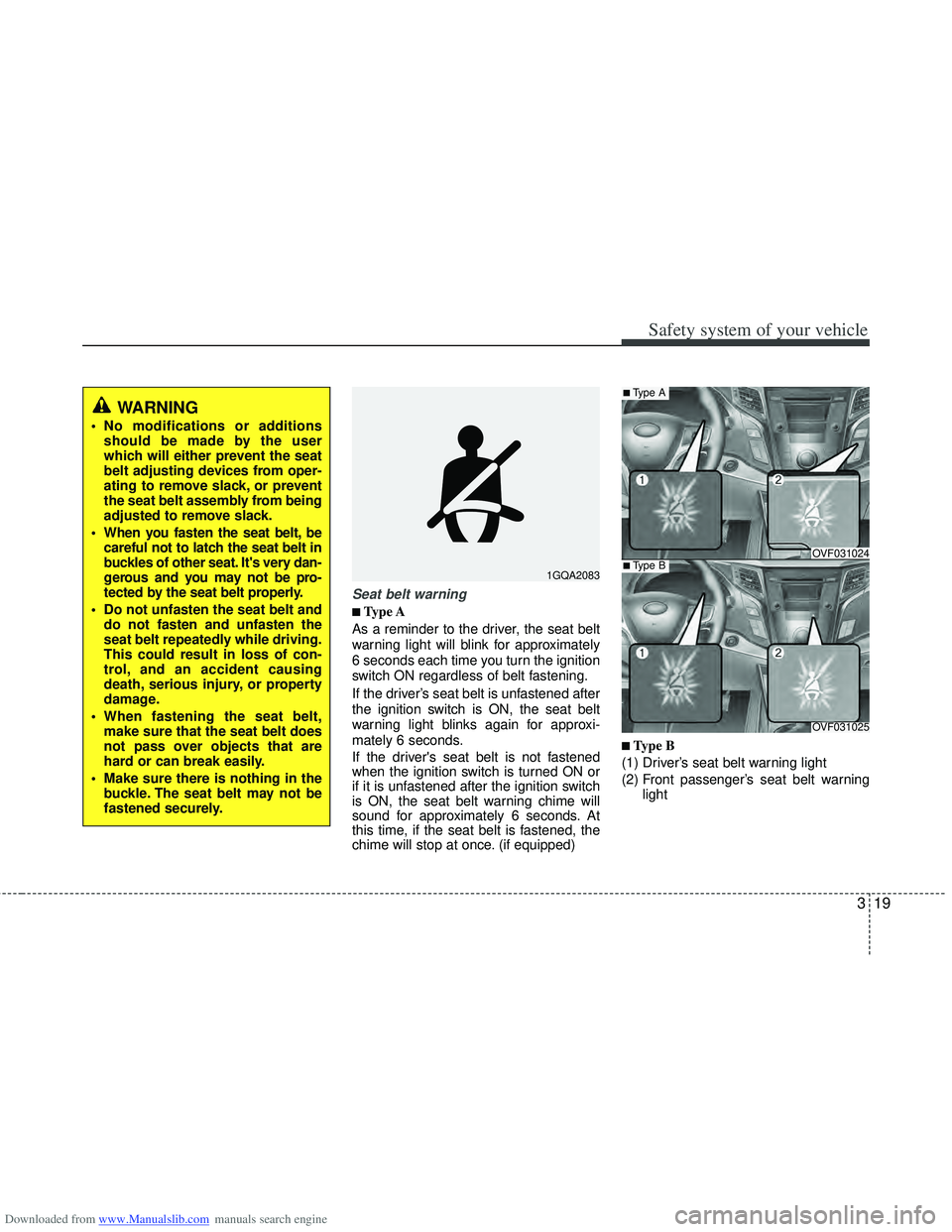
Downloaded from www.Manualslib.com manuals search engine 319
Safety system of your vehicle
Seat belt warning
■
■Type A
As a reminder to the driver, the seat belt
warning light will blink for approximately
6 seconds each time you turn the ignition
switch ON regardless of belt fastening.
If the driver’s seat belt is unfastened after
the ignition switch is ON, the seat belt
warning light blinks again for approxi-
mately 6 seconds.
If the driver's seat belt is not fastened
when the ignition switch is turned ON or
if it is unfastened after the ignition switch
is ON, the seat belt warning chime will
sound for approximately 6 seconds. At
this time, if the seat belt is fastened, the
chime will stop at once. (if equipped)
■ ■Type B
(1) Driver’s seat belt warning light
(2) Front passenger’s seat belt warning light
1GQA2083
WARNING
No modifications or additionsshould be made by the user
which will either prevent the seat
belt adjusting devices from oper-
ating to remove slack, or prevent
the seat belt assembly from being
adjusted to remove slack.
When you fasten the seat belt, be careful not to latch the seat belt in
buckles of other seat. It's very dan-
gerous and you may not be pro-
tected by the seat belt properly.
Do not unfasten the seat belt and do not fasten and unfasten the
seat belt repeatedly while driving.
This could result in loss of con-
trol, and an accident causing
death, serious injury, or property
damage.
When fastening the seat belt, make sure that the seat belt does
not pass over objects that are
hard or can break easily.
Make sure there is nothing in the buckle. The seat belt may not be
fastened securely.
OVF031025
■Type A
■Type BOVF031024
Page 44 of 534
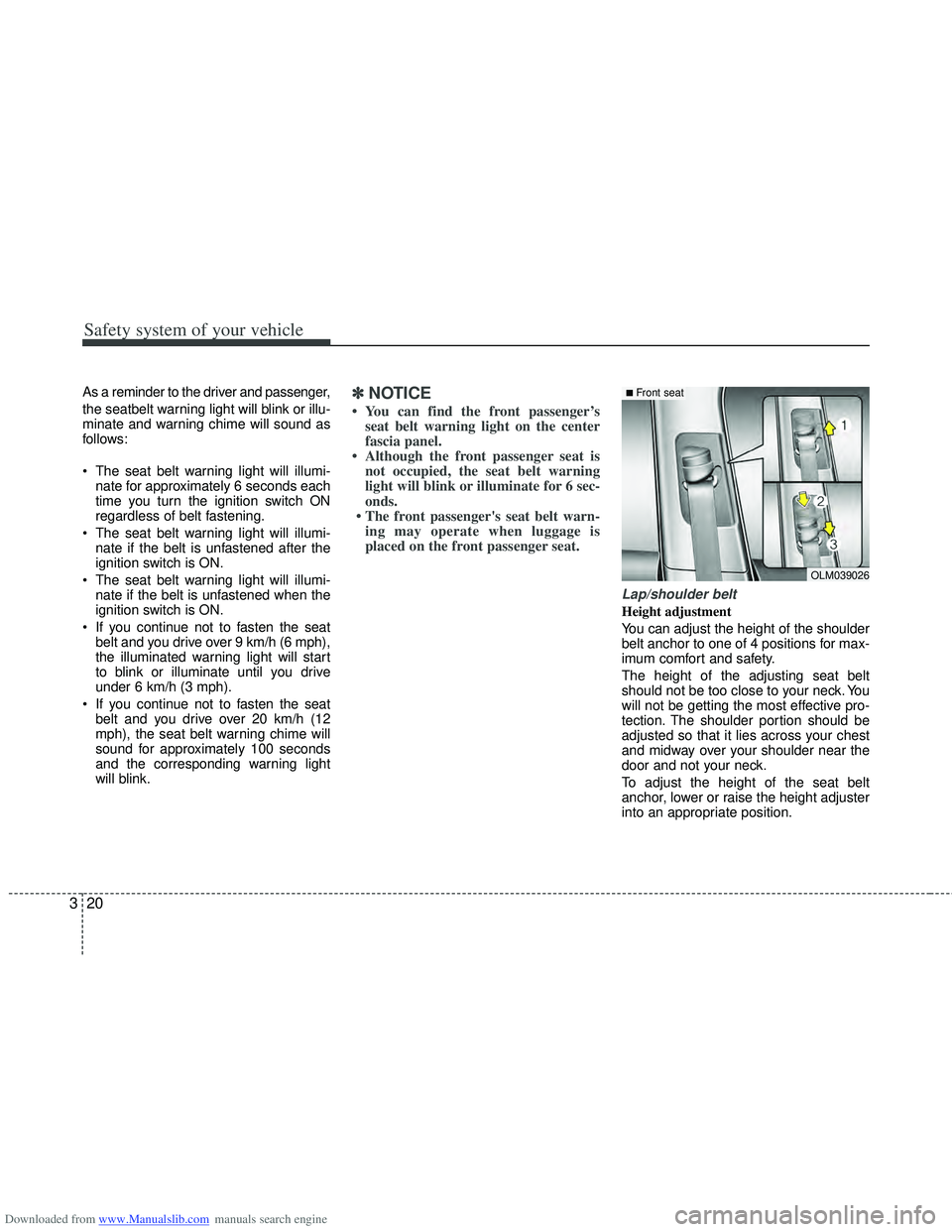
Downloaded from www.Manualslib.com manuals search engine Safety system of your vehicle
20
3
As a reminder to the driver and passenger,
the seatbelt warning light will blink or illu-
minate and warning chime will sound as
follows:
The seat belt warning light will illumi-
nate for approximately 6 seconds each
time you turn the ignition switch ON
regardless of belt fastening.
The seat belt warning light will illumi- nate if the belt is unfastened after the
ignition switch is ON.
The seat belt warning light will illumi- nate if the belt is unfastened when the
ignition switch is ON.
If you continue not to fasten the seat belt and you drive over 9 km/h (6 mph),
the illuminated warning light will start
to blink or illuminate until you drive
under 6 km/h (3 mph).
If you continue not to fasten the seat belt and you drive over 20 km/h (12
mph), the seat belt warning chime will
sound for approximately 100 seconds
and the corresponding warning light
will blink.✽ ✽ NOTICE
• You can find the front passenger’s
seat belt warning light on the center
fascia panel.
• Although the front passenger seat is not occupied, the seat belt warning
light will blink or illuminate for 6 sec-
onds.
• The front passenger's seat belt warn- ing may operate when luggage is
placed on the front passenger seat.
Lap/shoulder belt
Height adjustment
You can adjust the height of the shoulder
belt anchor to one of 4 positions for max-
imum comfort and safety.
The height of the adjusting seat belt
should not be too close to your neck. You
will not be getting the most effective pro-
tection. The shoulder portion should be
adjusted so that it lies across your chest
and midway over your shoulder near the
door and not your neck.
To adjust the height of the seat belt
anchor, lower or raise the height adjuster
into an appropriate position.
OLM039026
■Front seat
Page 48 of 534
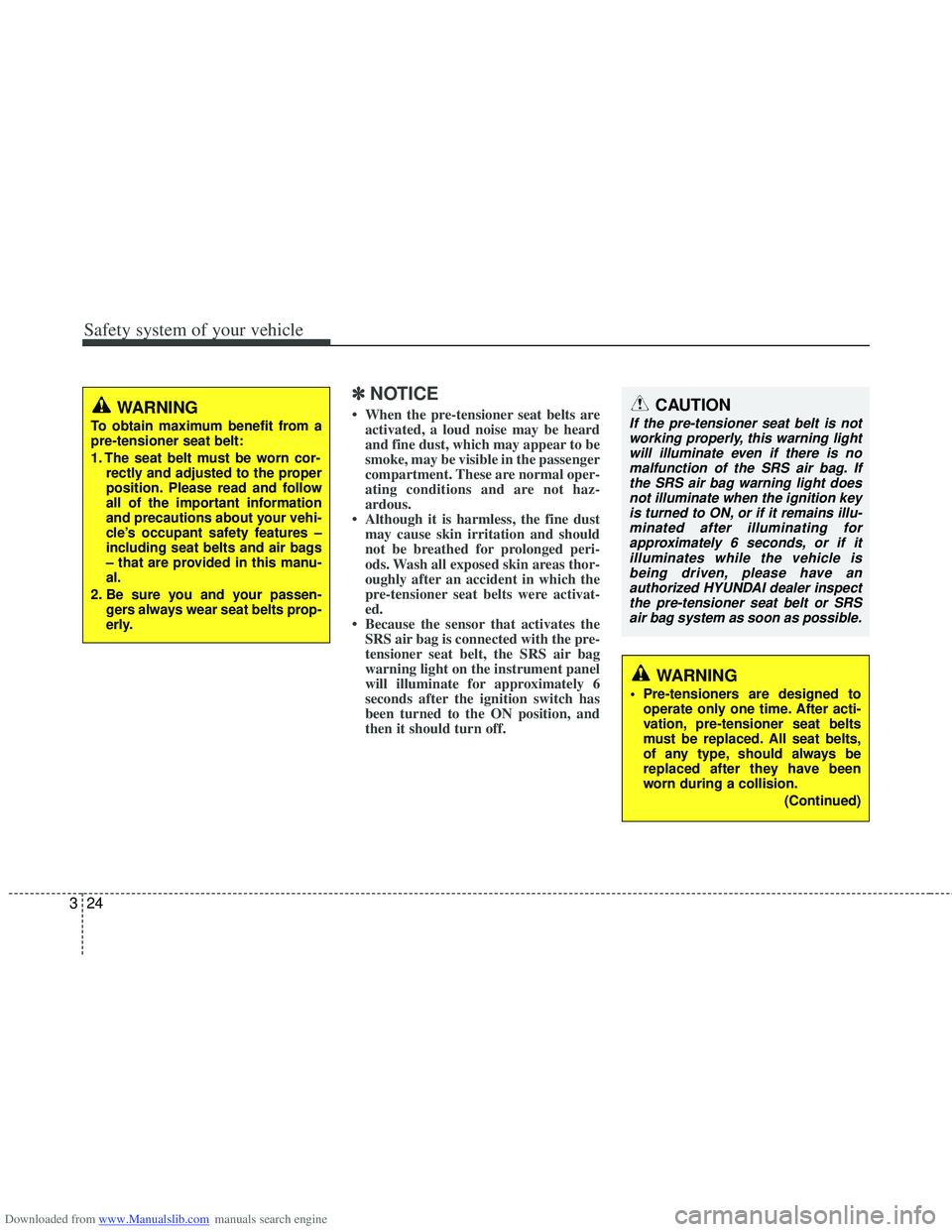
Downloaded from www.Manualslib.com manuals search engine Safety system of your vehicle
24
3
✽
✽
NOTICE
• When the pre-tensioner seat belts are
activated, a loud noise may be heard
and fine dust, which may appear to be
smoke, may be visible in the passenger
compartment. These are normal oper-
ating conditions and are not haz-
ardous.
• Although it is harmless, the fine dust may cause skin irritation and should
not be breathed for prolonged peri-
ods. Wash all exposed skin areas thor-
oughly after an accident in which the
pre-tensioner seat belts were activat-
ed.
• Because the sensor that activates the SRS air bag is connected with the pre-
tensioner seat belt, the SRS air bag
warning light on the instrument panel
will illuminate for approximately 6
seconds after the ignition switch has
been turned to the ON position, and
then it should turn off.CAUTION
If the pre-tensioner seat belt is not
working properly, this warning lightwill illuminate even if there is no malfunction of the SRS air bag. Ifthe SRS air bag warning light doesnot illuminate when the ignition key is turned to ON, or if it remains illu-minated after illuminating for approximately 6 seconds, or if itilluminates while the vehicle is being driven, please have anauthorized HYUNDAI dealer inspectthe pre-tensioner seat belt or SRSair bag system as soon as possible.
WARNING
Pre-tensioners are designed to operate only one time. After acti-
vation, pre-tensioner seat belts
must be replaced. All seat belts,
of any type, should always be
replaced after they have been
worn during a collision.
(Continued)
WARNING
To obtain maximum benefit from a
pre-tensioner seat belt:
1. The seat belt must be worn cor-rectly and adjusted to the proper
position. Please read and follow
all of the important information
and precautions about your vehi-
cle’s occupant safety features –
including seat belts and air bags
– that are provided in this manu-
al.
2. Be sure you and your passen- gers always wear seat belts prop-
erly.
Page 65 of 534
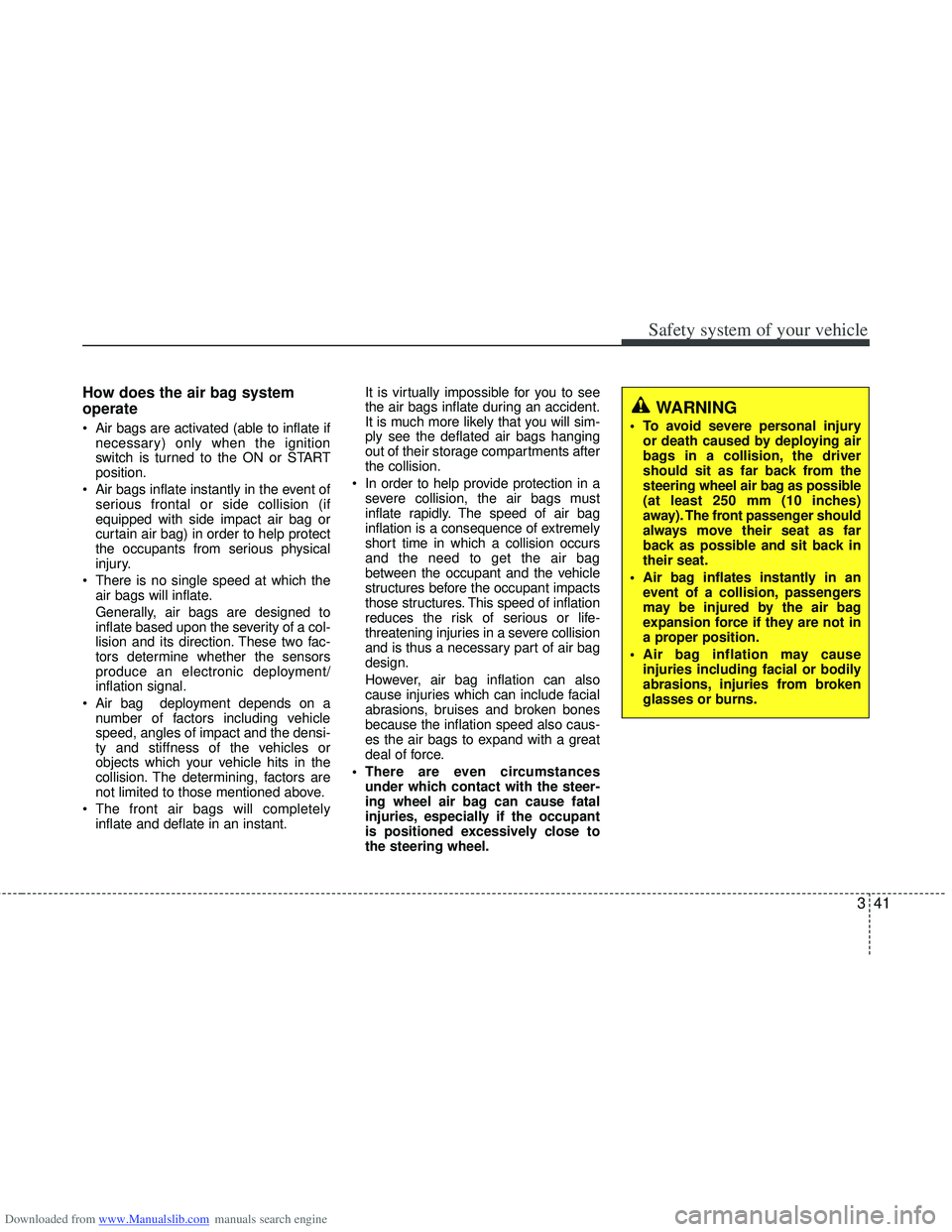
Downloaded from www.Manualslib.com manuals search engine 341
Safety system of your vehicle
How does the air bag system
operate
Air bags are activated (able to inflate ifnecessary) only when the ignition
switch is turned to the ON or START
position.
Air bags inflate instantly in the event of serious frontal or side collision (if
equipped with side impact air bag or
curtain air bag) in order to help protect
the occupants from serious physical
injury.
There is no single speed at which the air bags will inflate.
Generally, air bags are designed to
inflate based upon the severity of a col-
lision and its direction. These two fac-
tors determine whether the sensors
produce an electronic deployment/
inflation signal.
Air bag deployment depends on a number of factors including vehicle
speed, angles of impact and the densi-
ty and stiffness of the vehicles or
objects which your vehicle hits in the
collision. The determining, factors are
not limited to those mentioned above.
The front air bags will completely inflate and deflate in an instant. It is virtually impossible for you to see
the air bags inflate during an accident.
It is much more likely that you will sim-
ply see the deflated air bags hanging
out of their storage compartments after
the collision.
In order to help provide protection in a severe collision, the air bags must
inflate rapidly. The speed of air bag
inflation is a consequence of extremely
short time in which a collision occurs
and the need to get the air bag
between the occupant and the vehicle
structures before the occupant impacts
those structures. This speed of inflation
reduces the risk of serious or life-
threatening injuries in a severe collision
and is thus a necessary part of air bag
design.
However, air bag inflation can also
cause injuries which can include facial
abrasions, bruises and broken bones
because the inflation speed also caus-
es the air bags to expand with a great
deal of force.
There are even circumstances under which contact with the steer-
ing wheel air bag can cause fatal
injuries, especially if the occupant
is positioned excessively close to
the steering wheel.
WARNING
To avoid severe personal injuryor death caused by deploying air
bags in a collision, the driver
should sit as far back from the
steering wheel air bag as possible
(at least 250 mm (10 inches)
away). The front passenger should
always move their seat as far
back as possible and sit back in
their seat.
Air bag inflates instantly in an event of a collision, passengers
may be injured by the air bag
expansion force if they are not in
a proper position.
Air bag inflation may cause injuries including facial or bodily
abrasions, injuries from broken
glasses or burns.